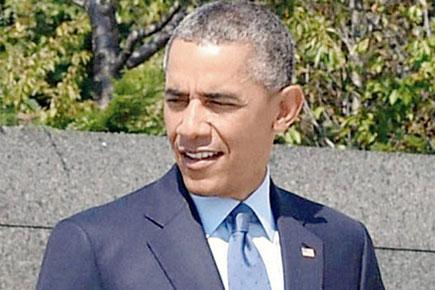When Barack Obama's Air Force One lands at the Indira Gandhi International Airport in New Delhi on Sunday, it would be the first long-distance solo country travel by any US President in the recent memory

Washington: When Barack Obama's Air Force One lands at the Indira Gandhi International Airport in New Delhi on Sunday, it would be the first long-distance solo country travel by any US President in the recent memory.
ADVERTISEMENT
In the past when the US President has been globe-trotting, his schedulers have always tried to include at least a few countries in his every overseas visit.
Obama would be flying across the globe for more than 12,000 kms just to attend India's 66th Republic Day Parade on January 26 as its Chief Guest at the invitation of Prime Minister Narendra Modi.
He will the first American President to be the Chief Guest at the Republic Day celebrations.
By accepting the invitation, Obama has also become the first US President to visit India twice. After Jimmy Carter, Obama is also the first US President, who has not visited Pakistan along with his India trip.
Obama did not travel to Pakistan when he visited India first in November 2010. Also the fact that he would be away from Washington for at least five days just only for one country, sends a message to not only the people of the US and India, but also to regional and global players about the importance the US attaches to strategic ties with India.
Dwight D Eisenhower was the first US President to visit India in December 1959. This was part of his nearly a month-long overseas trip, during which he visited nearly a dozen countries, including Pakistan.
It took 10 years for the next US President, Richard Nixon, to visit India in August 1969. In this foreign trip, Nixon visited as many as eight countries, including India and
Pakistan.
Nearly a decade later, Jimmy Carter made his sojourn to India in the first week of January, 1978. Carter travelled to seven countries, but skipped Pakistan. This was apparently because of the military coup in Pakistan by Zia-ul-Haq less than six months ago by overthrowing the elected government of Prime Minister Zulfikar Ali Bhutto.
There was a long pause of 12 years for any presidential visit to India, which was broken by Bill Clinton in March 2000.
In addition to India, Clinton visited Bangladesh, Pakistan and Oman during his trip which was towards the fag end of his second trip.
Thereafter, there has been no looking back as the India-US relationship has gained strength.
George Bush travelled to India in the first week of March 2006 wherein he travelled to Pakistan, Afghanistan, Ireland in addition to his all-important trip to India. When Obama visited India in November 2010, he also travelled to several other Asian countries ¿ Indonesia, South Korea and Japan. This was part of his pivot to Asia.
"This is a really big deal," said Rick Rossow, Wadhwani Chair in US-India Policy Studies at the Center for Strategic and International Studies.
"As we think about Asia in 20 and 30 years in the future, right, if we want a multi-polar Asia, it's going to be India. India's got to be part of that small discussion. "And if there's things that we can do to collaborate with India today to set that up for India to be a stronger friend and partner to the United States 20 and 30 years down the road you feel very much that the administration is back on board with doing that," he said.
"So it is extremely significant for the President to go back to India a second time, to do it only as an India trip, to be the guest for Republic Day. The symbolism of all this is tremendous," Rossow said.
 Subscribe today by clicking the link and stay updated with the latest news!" Click here!
Subscribe today by clicking the link and stay updated with the latest news!" Click here!






